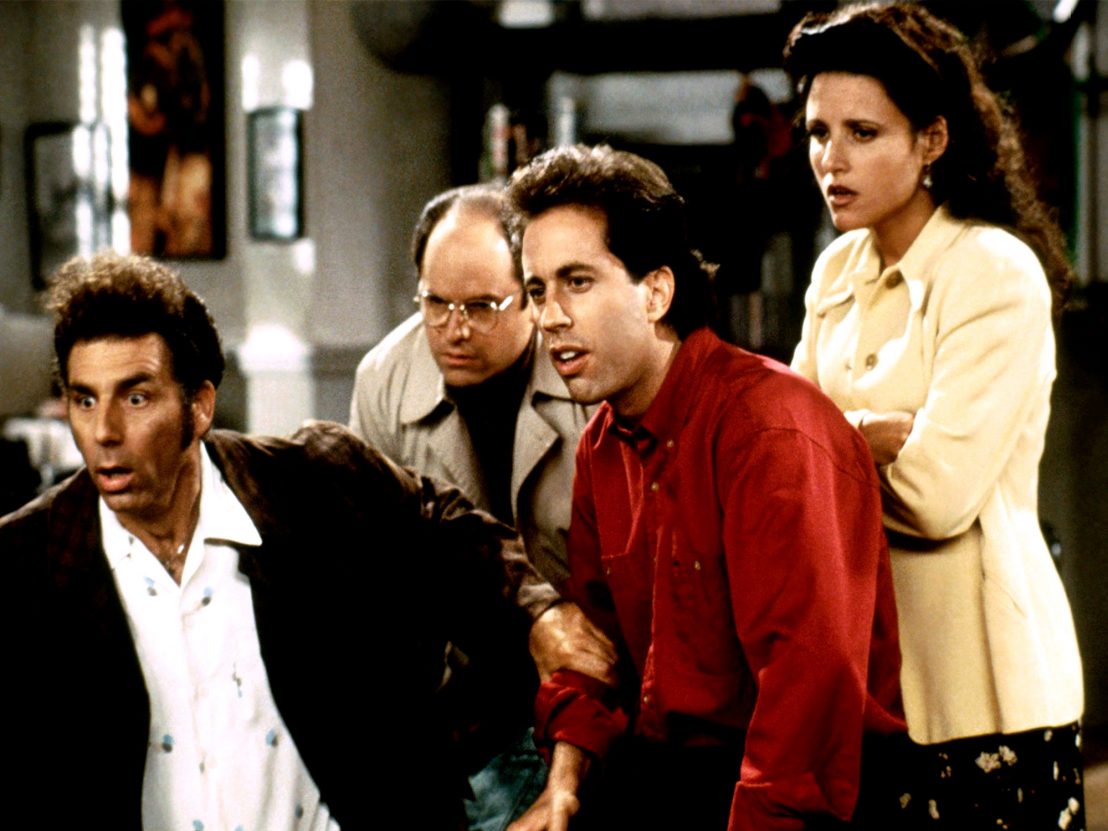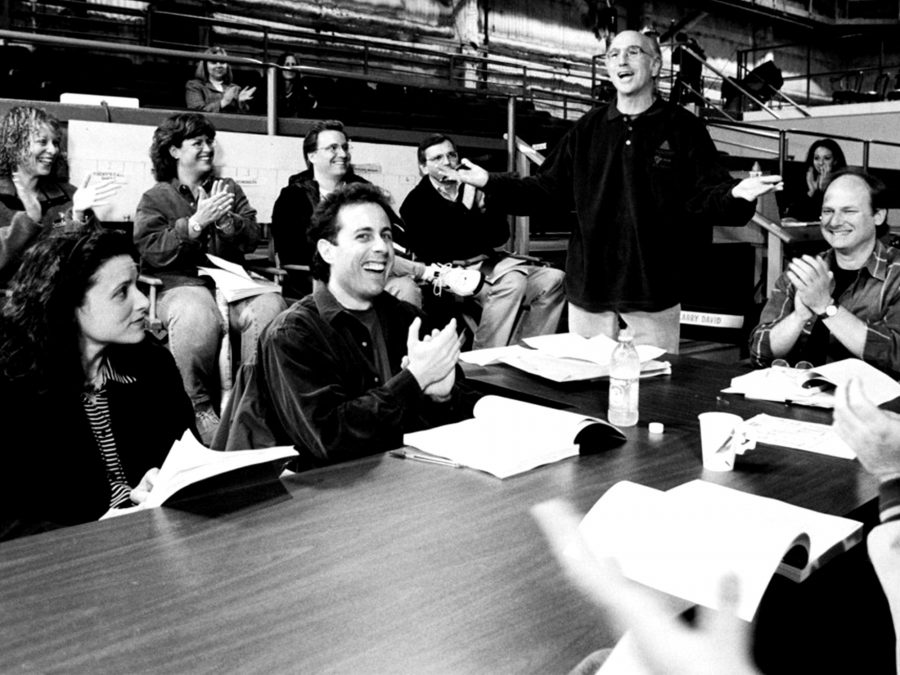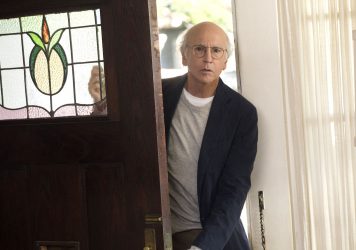
How Jerry Seinfeld and Larry David, two stand-up comedians with contrasting worldviews, made the most influential sitcom of the ’90s.
One night in November, 1988, Jerry Seinfeld and Larry David popped into a Korean Deli in New York for some snacks and came out with an idea. Seinfeld was the more successful of the two comedians, an observational grandmaster who worked clean and had become a regular fixture on the nation’s talk shows. David was the acerbic comedian’s comedian, fond of referring to the audience as “you people” and notorious for the time he walked on stage, assessed the crowd and said “forget it” before storming off.
Like Lennon and McCartney, the pair seemed unlikely bedfellows, but the combination of darkness and light was the first of many happy accidents that would become a trademark of the Seinfeld story.
Seinfeld, who was by now becoming a household name, was called in for a meeting with NBC. Deciding that a sitcom was the next logical step in his career, he quickly recruited David for the simple reason that he was the only comic he knew who had actually written something (an unproduced screenplay entitled ‘Prognosis Negative’). As they walked around mocking anything and everything for sale in the grocery store, David turned to his friend and remarked, ‘This is the kind of discussion you don’t see on TV.’
In the 1980s, with the exception of Taxi, Cheers and It’s Garry Shandling’s Show, American TV comedy was broad and tended to favour didactic stories in which enemies became friends by the end of the half hour. Seinfeld, which first aired on 5 July, 1989, had one overarching mantra that perfectly captures the show’s weltanschauung: ‘No hugging, no learning.’ Seinfeld once claimed that, “Ninety per cent of the show comes from Larry,” and David’s aim was to present a world as petty and absurd as he saw it.
David was in his forties by the time of that meeting with NBC and felt he had nothing to lose. Few writers have taken the idea of writing what you know as far as the man who went on to create Curb your Enthusiasm. The pilot, known as The Seinfeld Chronicles, saw Jerry Seinfeld play Jerry Seinfeld, a successful stand-up living in New York. His best friend, George Costanza, was David’s on-screen avatar while his neighbour, Kramer, was modelled on Larry’s actual neighbour during his time living in New York City, Kenny Kramer.
The episode, which was co-written by David and Seinfeld, was despised by test audiences and criticised by one NBC executive for being, “Too New York, too Jewish.” The show about nothing may have gone on to change everything but at the time it left many people wondering why they should care about a man doing his laundry. The result was the smallest order in the history of American television – a four episode first season.
David was relieved, feeling he hardly had any more ideas and there was no chance the show would be renewed given the lack of faith shown by the network early on. When the showrunner received the call that the show was being picked up for a third season, he sat on his bed and cried in the genuine belief that he’d already used up every last idea he could possibly have. There is something beautiful about this tale of imposter syndrome, not only that David would do something as profoundly un-American and un-showbiz as feeling such feelings but that he’d go so far as to admit it publicly.

Those early episodes of Seinfeld have an almost theatrical quality, calling to mind the naturalism of David Mamet or Harold Pinter as well as the independent American cinema of the early 1990s. By the time of the second episode, ‘The Stake Out’, Julia Louis-Dreyfus had replaced the wisecracking waitress character played by Lee Garlington. The latter is very much the Pete Best of this particular fab four; accounts differ as to why she left the show but the best story is told by Jason Alexander, who claims he saw her rewrite sections of the script and the look on Larry David’s face was enough for him to be able to tell her days were numbered.
Alexander, Louis-Dreyfus and Michael Richards more than made up for Seinfeld’s own lack of experience in front of the camera. From the off, the fact that the creators didn’t really know what they were doing proved entirely beneficial; the lack of a writers’ room meant that scripts weren’t gagged up by committee and, more often than not, had an idiosyncratic feel that supports the theory that the specific is universal. The more the show homed in on the minutiae of everyday life, the more it found fans all over the globe. The first three seasons almost stand alone with plots rarely overlapping and episodes playing out like miniature plays. There is plenty of space for digressions and the influence of the dialogue can be detected in films of the era like Reservoir Dogs and Swingers.
Seasons four to six represent the golden age, the era when Seinfeld became a cultural phenomenon, its phrases entered the lexicon and the cast and crew no longer had to worry about overtaking Jake and the Fatman in the ratings. Many of the show’s most celebrated episodes aired during these years, not least ‘The Contest’, an entire half hour devoted to onanism without anyone actually uttering the word ‘masturbation’. Necessity is the mother of invention and by that stage David was a master at getting contentious material past the censors. He won an Emmy for his work on the episode and memorably opened his acceptance speech with the words, “This is all well and good… but I’m still bald.” He was still bald in 2009 when TV Guide named ‘The Contest’ the best ever episode of television.
The final three seasons of Seinfeld saw the show embrace its inner Kramer and become broader and more cartoonish, a far cry from the initial mission statement. David left at the end of the seventh series and seasons eight and nine in particular, while funny, feel almost unrecognisable from the early days. The co-creator returned to pen the finale, a scathing and polarising double episode that concluded with the protagonists behind bars. Seventy-six million people tuned in to watch that farewell, a figure that will surely never be emulated given how dramatically our viewing habits have changed since.

Seinfeld popularised concepts like double dipping, shrinkage and close talkers. The intricate plotting was unparalleled and the acting flawless. Roseanne Barr once complained, “They think they’re doing Beckett instead of a sitcom,” without realising this is no bad thing. In 1998, in an interview to promote Sour Grapes, his debut feature film, David said: “Without Seinfeld, would there be a Friends? Would that show have ever been done without Seinfeld? That format, what they’re doing? No.”
The irony is that Friends gave birth to a number of shows viewed as Friends clones when in fact Seinfeld was the origin of it all. Friends simply cast more attractive actors and reinserted the hugging and learning. Ricky Gervais and Stephen Merchant have made no secret of the influence Seinfeld had on their own epochal sitcom, The Office. That in turn inspired an entire generation of British comedies as well as an American remake that led to a surge in television mockumentaries including Parks and Recreation, Modern Family and, most recently, What We Do in the Shadows.
In a sense, all of this can be seen as happening by chance. NBC didn’t call Seinfeld in for a meeting because they thought he’d redefine the sitcom and he didn’t ask his friend for help because he thought David would change the game. Neither man watched much television so they were hardly aware of the level of innovation involved in Seinfeld. All Seinfeld and David really wanted to do was to put real life on screen in a way that made them laugh.
The media landscape has changed beyond all recognition since the inauspicious debut of Seinfeld 30 years ago. In an appearance together on Saturday Night Live in 2015, Seinfeld and David reflected on all this with the former coming to the conclusion, “It’s like we had the last two tickets before Disneyland burned down.” No show in 2019 would be given the kind of time Seinfeld was allowed to build an audience and yet patience paid off with the show not reaching its creative peak until the fourth season.
The legacy of Seinfeld is not simply in the shows it inspired, it’s in any creative type who’s ever fought for creative freedom and won. David wasn’t interested in making his characters likeable; his only concern was that they were funny. Executives were adamant George and Jerry should be polar opposites but the co-creator countered by asking why they’d be friends.
Seinfeld deserves the last word. At one point in the series, Jerry is complaining about people who board planes with nothing to read and Elaine comments, “I will never understand people.” Jerry replies, “They’re the worst.” They are, but occasionally they’re capable of creating art as perfect as Seinfeld.
Published 4 Jul 2019

Larry David’s semi-improvised comedy paved the way for an entire new generation of shows.

By Al Horner
Sharon Horgan and Rob Delaney bow out after four riotously funny seasons.

Twenty-five years on, the show’s mix of high-brow humour and genuine heart is as appealing as ever.